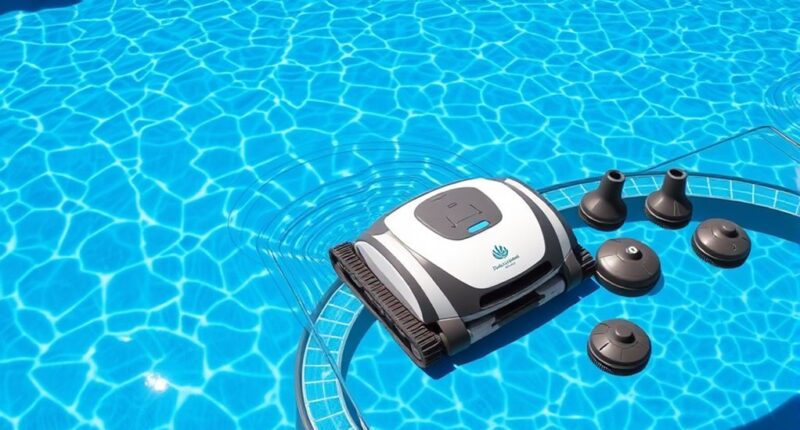The automatic pool cleaners industry is growing fast, driven by your demand for easy, efficient pool maintenance. You’ll find various types like robotic, suction-side, and pressure-side models, each with smart tech features that improve cleaning. Major brands are competing through innovation and affordability. Challenges like high costs and battery life are being addressed with new technologies. Keep exploring to discover how future trends and advancements will keep your pool spotless with less effort.
Key Takeaways
- The industry is growing due to increased demand for convenient, automated pool maintenance solutions across residential and commercial markets.
- Main types include robotic, suction-side, and pressure-side cleaners, featuring advanced sensors and automation technologies.
- Leading companies like Dolphin, Polaris, and Hayward dominate through innovation, reliability, and expanding distribution channels.
- Challenges include high product costs, limited battery life, and regulatory compliance, impacting affordability and safety.
- Future trends focus on smart device integration, energy efficiency, eco-friendly designs, and enhanced remote diagnostics.
Market Overview and Growth Drivers
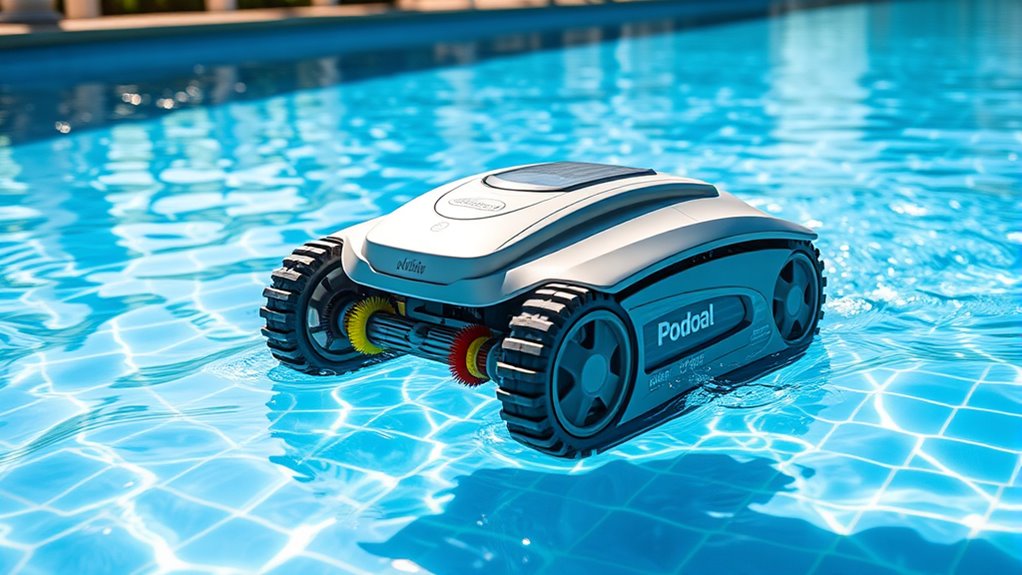
The automatic pool cleaners industry is experiencing significant growth driven by rising consumer demand for convenient and efficient pool maintenance solutions. As a result, more homeowners prioritize easy, time-saving methods to keep their pools clean. Consumer preferences lean toward automated systems that reduce manual effort, offering reliable and consistent cleaning. This shift boosts market expansion, with manufacturers investing in innovative features to meet these needs. The appeal of energy-efficient, user-friendly devices fuels adoption across residential and commercial sectors. Additionally, increased awareness of water quality and hygiene encourages consumers to seek effective cleaning options. The integration of advanced technology such as sensors and automation enhances overall performance and user experience. Furthermore, understanding the energy consumption of these devices can help consumers choose options that are both effective and environmentally friendly, supporting sustainable practices. Incorporating regulatory standards ensures these products meet safety and efficiency benchmarks, which is increasingly important for consumer trust. Market players are also exploring market expansion opportunities in emerging regions to further grow the industry. The rapid evolution of product innovation continues to attract new customers seeking smarter, more efficient cleaning solutions. Overall, the industry’s growth is fueled by the desire for hassle-free pool maintenance, aligning with evolving consumer expectations for smarter, more efficient cleaning solutions.
Types and Features of Automatic Pool Cleaners
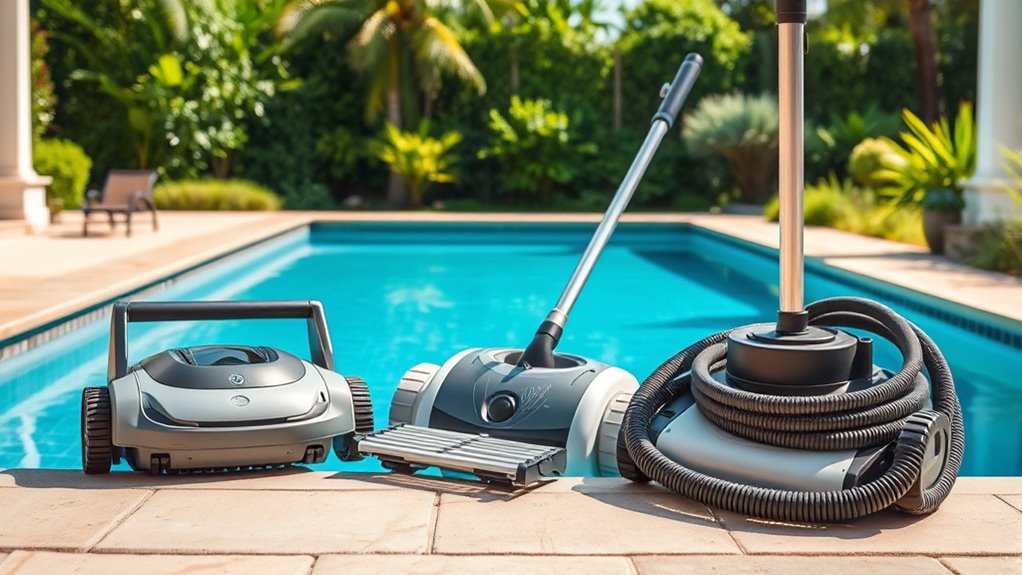
Are you aware of the different types of automatic pool cleaners available today? You can choose from robotic cleaners, suction-side, or pressure-side models, each offering unique features. Robotic technology provides precise cleaning and often includes smart navigation, making them highly efficient. These cleaners are known for their energy efficiency, saving you money while keeping your pool spotless. Suction-side cleaners connect to your skimmer and are ideal for light cleaning needs. Pressure-side cleaners use the pool’s existing pressure to operate and can handle larger debris. Here’s a quick look:
| Type | Key Feature | Energy Efficiency |
|---|---|---|
| Robotic | Advanced navigation | High |
| Suction-side | Easy installation | Moderate |
| Pressure-side | Handles big debris | Good |
Additionally, some models incorporate smart technology to further improve cleaning performance and user convenience. Understanding pool maintenance can help you select the most suitable cleaner for your needs. Proper knowledge of the different pool cleaner types can also aid in making an informed decision based on your specific requirements and budget. Recognizing the benefits of energy-efficient models can lead to long-term savings and more sustainable pool care. Moreover, considering cost factors can assist in choosing a model that fits your budget while providing optimal performance.
Key Industry Players and Market Share
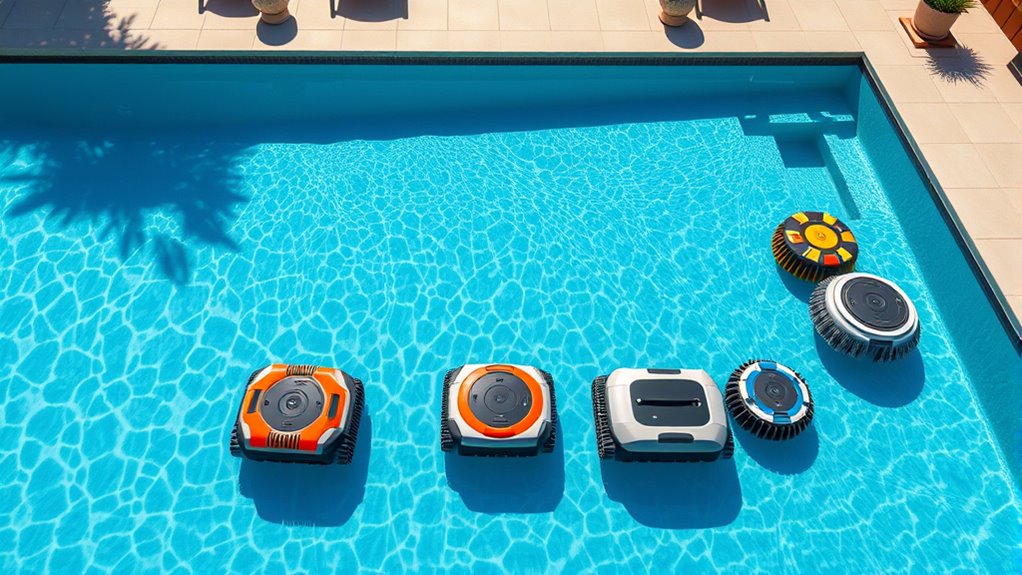
Several leading companies dominate the automatic pool cleaner industry, shaping market trends and innovation. These key players focus on competitor strategies like product differentiation and aggressive marketing to capture market share. They target specific market segmentation, such as residential versus commercial pools, tailoring their offerings accordingly. Major brands like Dolphin, Polaris, and Hayward hold significant portions of the market by constantly refining their models and expanding distribution channels. Their strategies include competitive pricing, brand loyalty, and product reliability to stay ahead. Additionally, understanding the influence of market share dynamics helps industry stakeholders anticipate shifts and adapt their strategies effectively. The industry’s competitive landscape is also influenced by product innovation, which drives companies to develop more efficient, user-friendly, and technologically advanced pool cleaners. As a result, the industry sees a competitive landscape where market share shifts based on innovation, affordability, and customer preferences. Recognizing the importance of consumer demand enables companies to better align their offerings with evolving preferences. Understanding these key players and their strategies helps you grasp how the industry evolves and remains dynamic. Furthermore, the ability to adapt to changing market dynamics is crucial for sustaining growth and competitiveness in this industry.
Technological Innovations and Advancements
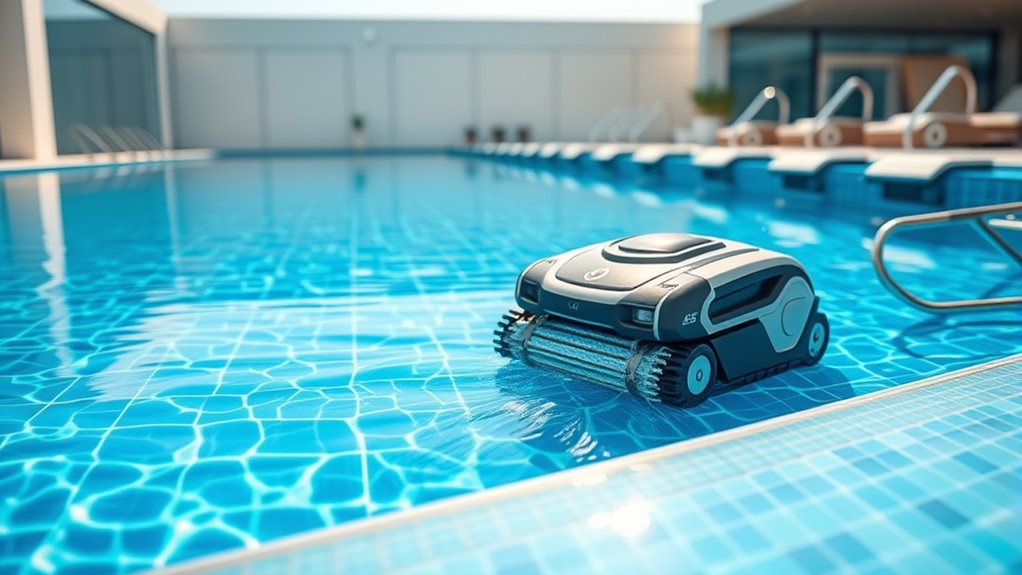
Advancements in sensor technology and automation have revolutionized automatic pool cleaners, making them smarter and more efficient. You now benefit from improved robotic efficiency, as sensors enable precise navigation and obstacle avoidance. Sensor integration allows these devices to adapt to varying pool conditions, optimizing cleaning patterns. For example, newer models use advanced sensors to detect dirt levels and adjust cleaning intensity accordingly. This innovation reduces energy consumption and enhances overall performance. Additionally, integrating Bitcoin IRA strategies can provide long-term financial benefits for pool maintenance investments. The table below highlights key technological features:
| Feature | Benefit |
|---|---|
| Sensor Integration | Improved navigation and dirt detection |
| Automated Scheduling | Customizable cleaning routines |
| Real-Time Feedback | Performance monitoring and adjustments in real-time |
These innovations ensure a more effective, efficient, and user-friendly cleaning experience. Furthermore, the incorporation of smart sensor networks allows for seamless communication between pool devices and home automation systems, further optimizing maintenance routines. Additionally, advancements in sensor technology, such as adaptive sensing, from the industry have contributed to the development of more intelligent cleaning solutions, supporting the trend toward automated maintenance in pool care.
Challenges and Opportunities in the Industry
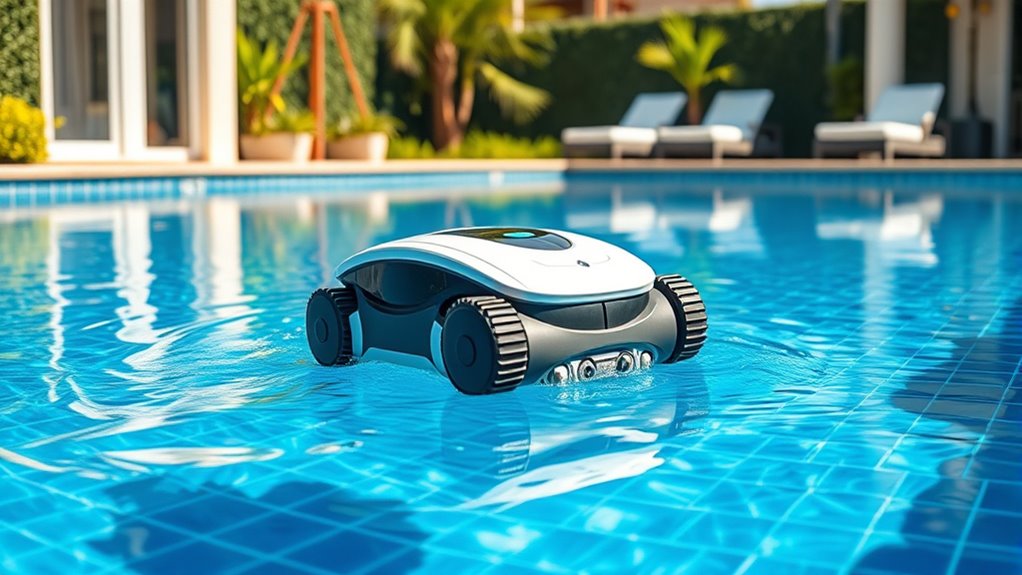
Despite the rapid technological progress, the automatic pool cleaner industry faces significant challenges such as high product costs, limited battery life, and compatibility issues with various pool types. These obstacles can impact customer satisfaction, as users seek reliable, efficient, and affordable solutions. Manufacturers must balance innovation with affordability to meet consumer expectations. Additionally, regulatory compliance poses a growing challenge, requiring companies to adhere to safety and environmental standards, which can increase costs and development time. To address these issues, companies are exploring advanced battery technology that offers longer life and faster charging capabilities. Moreover, ongoing research into safety standards can help manufacturers develop more compliant and trustworthy products. Keeping up with regulatory requirements is essential for maintaining market access and avoiding potential legal issues. Efficient product design can also play a crucial role in overcoming these hurdles. However, these challenges also present opportunities. By improving battery technology, reducing costs, and ensuring compatibility across pool types, you can enhance customer satisfaction and gain a competitive edge. Orchestrating regulatory requirements effectively can also build trust and brand reputation, opening doors to new markets. Implementing compliance strategies can streamline this process and facilitate smoother market entry.
Future Trends and Market Outlook
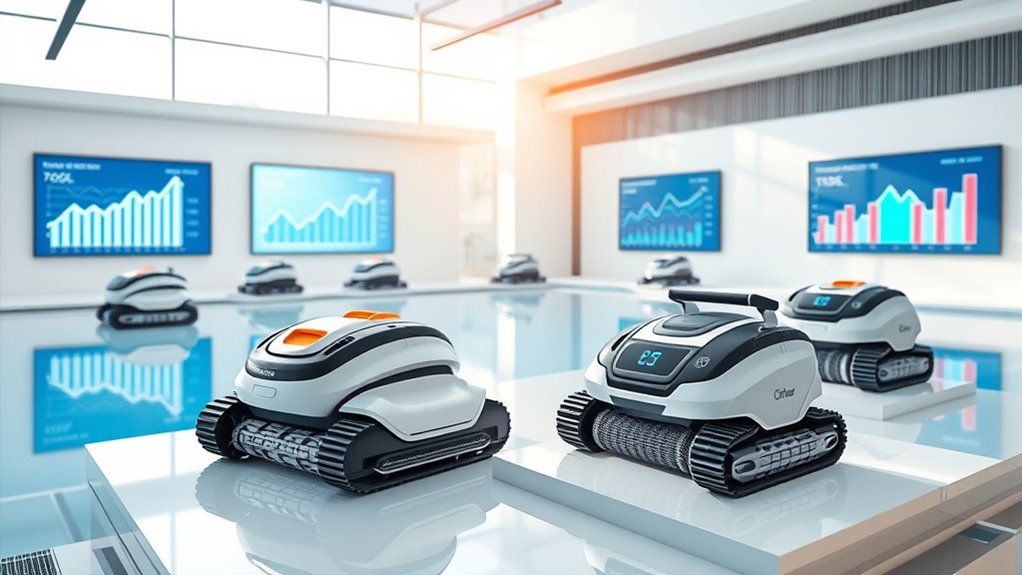
The future of the automatic pool cleaner industry is poised for significant growth driven by ongoing technological innovations and shifting consumer preferences. You can expect smarter integration of devices, allowing automatic pool cleaners to connect seamlessly with home automation systems. This will enable more efficient scheduling, remote control, and real-time diagnostics. Additionally, eco-friendly design will become a key market trend, as consumers prioritize sustainability. Manufacturers are likely to focus on energy-efficient motors, biodegradable materials, and water-saving features. As awareness of environmental impact grows, these innovations will appeal to eco-conscious buyers. Furthermore, the adoption of high-pressure systems similar to those used in airless paint sprayers will enhance cleaning efficiency and coverage. Overall, the industry will see increased adoption of advanced, sustainable solutions that enhance convenience, performance, and environmental responsibility, shaping a dynamic and forward-looking market landscape.
Frequently Asked Questions
What Are the Environmental Impacts of Automatic Pool Cleaners?
You might wonder about the environmental impacts of automatic pool cleaners. These devices can be eco-friendly if made from sustainable, eco-friendly materials and designed to promote water conservation. By using energy-efficient motors and reducing chemical use, they help lower your ecological footprint. However, some models may consume more electricity or contain non-biodegradable parts, so choosing eco-conscious options guarantees your pool maintenance aligns with environmental preservation efforts.
How Does Maintenance Vary Among Different Pool Cleaner Models?
When comparing pool cleaner models, maintenance varies based on filter types and usage. You’ll find that some filters require weekly cleaning, while others need less frequent attention. For example, cartridge filters need regular rinsing, whereas sand filters might last longer but require occasional backwashing. Your maintenance frequency depends on the cleaner’s design and your pool’s debris load. Selecting the right model guarantees easier upkeep and consistent cleaning performance.
Are There Safety Concerns Associated With Automatic Pool Cleaners?
You should be aware that automatic pool cleaners can pose safety hazards if not used properly. For example, moving parts might cause injury, or electrical components could lead to shocks if damaged or improperly maintained. To guarantee user safety, always follow manufacturer instructions, keep the area clear of obstructions, and unplug the device before servicing. Staying cautious helps prevent accidents and keeps your pool cleaning experience safe.
What Is the Average Lifespan of an Automatic Pool Cleaner?
Think of your pool cleaner as a loyal steed, meant to serve faithfully. On average, its lifespan—pool cleaner longevity—ranges from 3 to 8 years, depending on maintenance factors. Regular cleaning, timely filter changes, and proper storage can extend this life. Neglect, however, accelerates wear and tear, turning your trusty helper into a fading memory. Proper care ensures your cleaner remains a steadfast guardian of sparkling waters.
How Do Regional Regulations Affect the Industry’S Growth?
Regional policies profoundly influence industry expansion by setting standards for safety, environmental impact, and product efficiency. If policies are strict, manufacturers might face higher compliance costs, slowing growth. Conversely, supportive policies can encourage innovation and market entry. As a consumer, you’ll notice these regulations shaping product availability and quality. Staying informed about regional policies helps you understand industry trends and choose pool cleaners that meet local standards, ensuring safety and performance.
Conclusion
By 2028, the automatic pool cleaner industry is projected to reach over $2 billion globally, reflecting rapid growth and innovation. As you explore this market, you’ll find cutting-edge technologies making pool maintenance easier and more efficient. With autonomous robots improving cleaning times by up to 50%, it’s clear that this industry’s future is bright. Stay ahead by understanding these trends—you’re witnessing the evolution of a cleaner, smarter pool experience.
